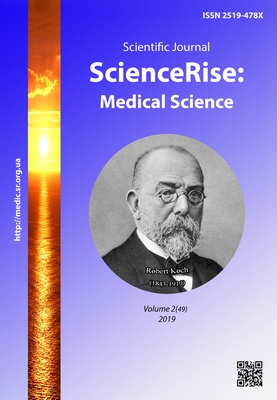Motor and non-motor manifestations of benign multiple sclerosis: the results of a 5-year prospective study
DOI:
https://doi.org/10.15587/2519-4798.2019.161729Keywords:
multiple sclerosis, benign multiple sclerosis, failure, prospective study, functional scalesAbstract
The aim of our work was to assess the motor and non-motor effects of the disease in patients with benign multiple sclerosis (MS) during the 5-year follow-up period.
Materials and methods: the observational, prospective five-year, double-blind study of patients with benign MS was conducted for the first time in Ukraine. On the basis of the electronic register of patients with multiple sclerosis in the Volyn region, a group of patients with benign multiple sclerosis according to the following criteria: duration of MS for more than 10 years, full or partial working capacity, degree of disability of EDSS ≤4 points was allocated in 2012-2013. In 2017–2018 a reassessment of patients with benign MS was performed. According to the degree of disability on the EDSS scale, at the stage of inclusion in the study, patients were divided into three groups: the first group includes patients with a degree of EDSS ≤2.0 points, to the second group - with an EDSS degree of 2.5–3.5 points, to the third group - with the degree of EDSS ≤4.0 points.
Results: there were included 74 persons, age 46.44±8.36 years into analyses. According to the degree of EDSS step at the stage of inclusion in the study, patients were divided into three groups. The demographic, clinical and paraclinical characteristics were evaluated. It has been established that the initial level of functional disability on the EDSS scale is not a determining factor in the assessment of the level of disability and employment after 5 years. Progression of the disease was observed regardless of the initial level of EDSS in at least two functional scales.
Conclusions: the proportion of benign multiple sclerosis after 15 years of follow-up was 9.76 %. With a lower initial score on the EDSS scale, there is an increase in motor manifestations, with more – non-motor syptoms of multiple sclerosis. Progression of the disease is observed in at least two functional scales
References
- Thompson, A. J., Banwell, B. L., Barkhof, F., Carroll, W. M., Coetzee, T., Comi, G. et. al. (2018). Diagnosis of multiple sclerosis: 2017 revisions of the McDonald criteria. The Lancet Neurology, 17 (2), 162–173. doi: http://doi.org/10.1016/s1474-4422(17)30470-2
- Mischenko, T. S., Shulga, O. D., Bobryk, N. V., Shulga, L. A. (2014). Multiple Sclerosis: Global Perspectives. Ukrainian Medical Journal, 3, 84–87.
- Atlas of MS Database Data Export: Number of People with MS (2013). Multiple Sclerosis International Federation. Available at: http://www.atlasofms.org
- Shulga, O. D. (2014). Socio-economic status of patients with multiple sclerosis: results of the registry in Volyn. Problems of Continuous Medical Education and Science, 4, 12–14. Available at: http://nbuv.gov.ua/UJRN/Psmno_2014_4_5
- Giovannoni, G., Butzkueven, H., Dhib-Jalbut, S., Hobart, J., Kobelt, G., Pepper, G. et. al. (2016). Brain health: time matters in multiple sclerosis. Multiple Sclerosis and Related Disorders, 9, 5–48. doi: http://doi.org/10.1016/j.msard.2016.07.003
- Shulga, O. D. (2016). Benign multiple sclerosis: criteria for determination, peculiarities of the course. Ukrainian neurological journal, 1, 85–88. Available at: http://nbuv.gov.ua/UJRN/UNJ_2016_1_15
- Fabis-Pedrini, M. J., James, I., Seewann, A., Yau, W. Y., van de Bovenkamp, A. A., Sanders, F. R. K. et. al. (2018). Natural history of benign multiple sclerosis: Clinical and HLA correlates in a Western Australian cohort. Journal of the Neurological Sciences, 388, 12–18. doi: http://doi.org/10.1016/j.jns.2018.02.036
- Razzolini, L., Portaccio, E., Stromillo, M. L., Goretti, B., Niccolai, C., Pastò, L. et. al. (2018). The dilemma of benign multiple sclerosis: Can we predict the risk of losing the “benign status”? A 12-year follow-up study. Multiple Sclerosis and Related Disorders, 26, 71–73. doi: http://doi.org/10.1016/j.msard.2018.08.011
- Polman, C. H., Reingold, S. C., Banwell, B., Clanet, M., Cohen, J. A., Filippi, M. et. al. (2011). Diagnostic criteria for multiple sclerosis: 2010 Revisions to the McDonald criteria. Annals of Neurology, 69 (2), 292–302. doi: http://doi.org/10.1002/ana.22366
- Kurtzke, J. F. (1983). Rating neurologic impairment in multiple sclerosis: An expanded disability status scale (EDSS). Neurology, 33 (11), 1444. doi: http://doi.org/10.1212/wnl.33.11.1444
Downloads
Published
How to Cite
Issue
Section
License
Copyright (c) 2019 Olga Shulga

This work is licensed under a Creative Commons Attribution 4.0 International License.
Our journal abides by the Creative Commons CC BY copyright rights and permissions for open access journals.
Authors, who are published in this journal, agree to the following conditions:
1. The authors reserve the right to authorship of the work and pass the first publication right of this work to the journal under the terms of a Creative Commons CC BY, which allows others to freely distribute the published research with the obligatory reference to the authors of the original work and the first publication of the work in this journal.
2. The authors have the right to conclude separate supplement agreements that relate to non-exclusive work distribution in the form in which it has been published by the journal (for example, to upload the work to the online storage of the journal or publish it as part of a monograph), provided that the reference to the first publication of the work in this journal is included.









